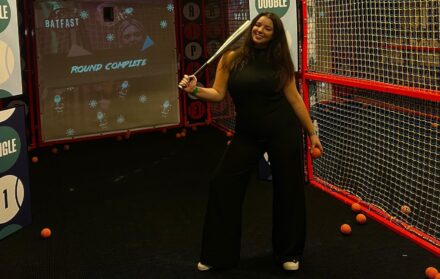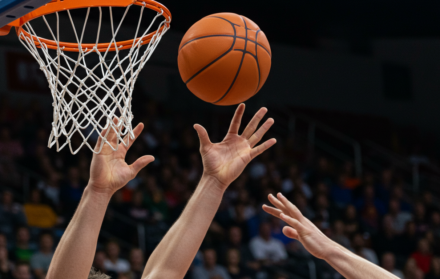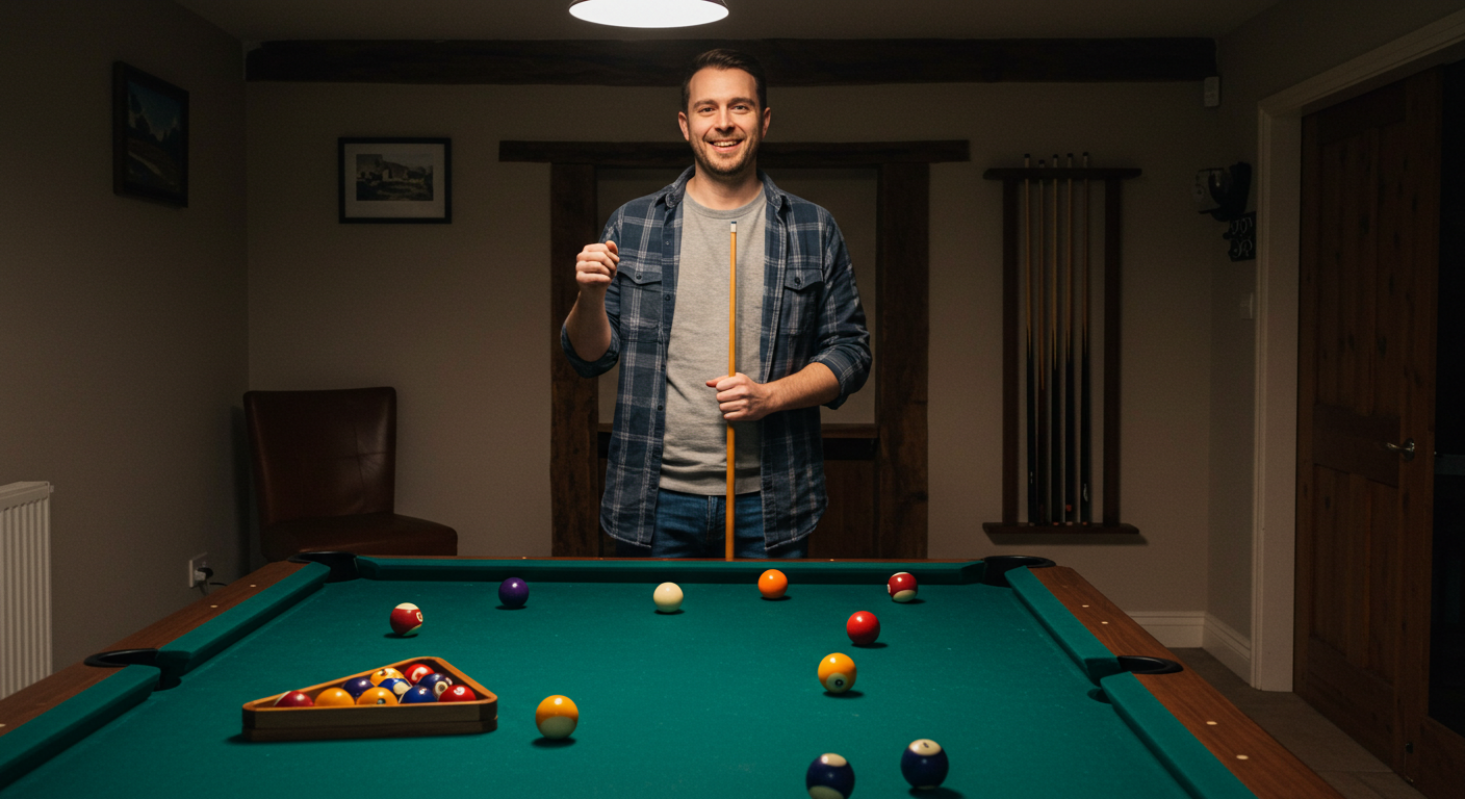
The Must-Have American Pool Table Equipment You Need for Your Home
Bringing American pool into your home can turn any spare room or garage into a social hotspot. Whether you’re an avid player looking to sharpen your skills or simply love the idea of entertaining friends with a casual game, having the right setup makes all the difference.
Unlike British pool or snooker, American pool uses a slightly different table size, cue length, and ball dimensions. It’s important to understand these differences when shopping for equipment to avoid mismatches. Plus, quality matters—a poor table or warped cues can take all the joy out of playing.
In this guide, we’ll break down every American pool table equipment you’ll need to create an authentic American pool experience at home. From the table and cues to lighting, cloths, and cleaning gear, we’ve got you covered. Whether you’re planning a sleek games room or a humble corner setup, these recommendations will help you build a kit that lasts.
Let’s get started with the centrepiece of any pool space—the table.
1. The Pool Table: Size, Quality, and Placement
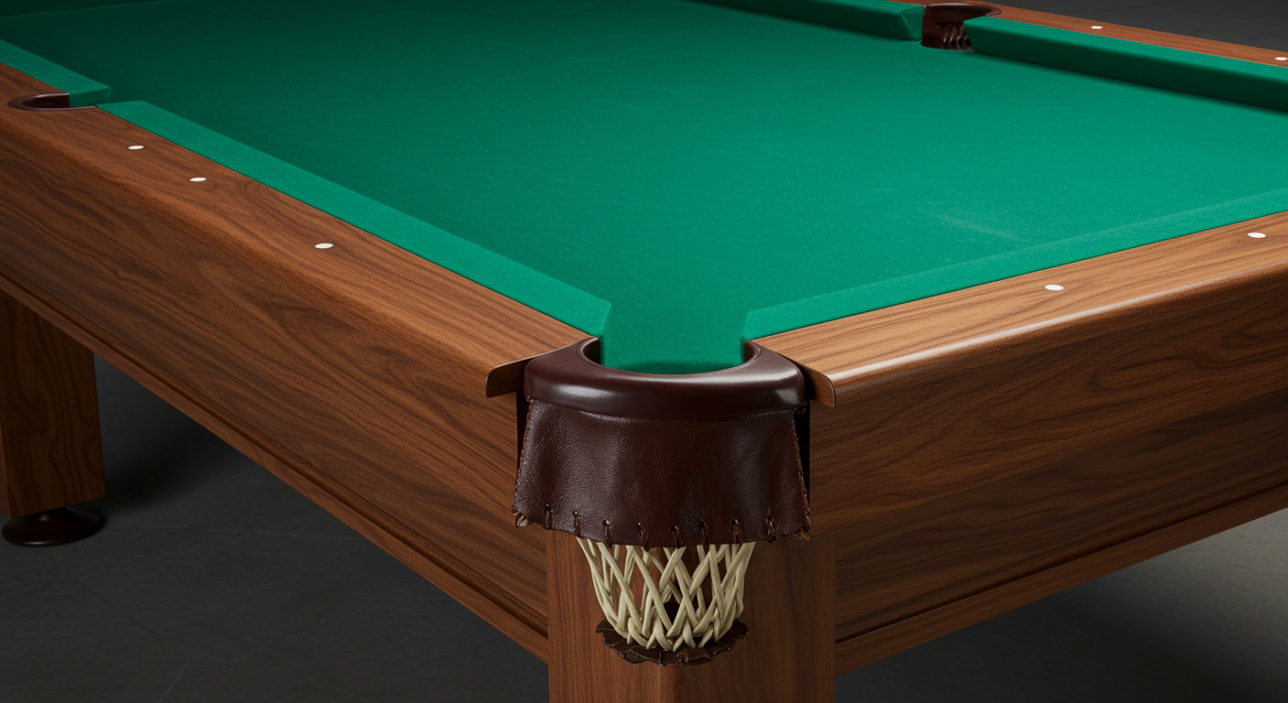
The pool table is the centrepiece of your home setup, so it’s worth investing in a quality one. American pool tables are typically larger than British ones, measuring 9 feet by 4.5 feet. However, for home setups, 7-foot or 8-foot tables are also common and more space-friendly.
When choosing a table, opt for one with a slate bed, which ensures a perfectly flat playing surface. MDF tables are cheaper but less durable and can warp over time. Look for solid wood frames, strong legs, and professional-grade rubber cushions to maintain consistent rebound.
You’ll also need sufficient space around the table—ideally, a minimum of 5 feet clearance on all sides for comfortable cue movement. Measure your room before purchasing to ensure a good fit.
Tables often come with accessories, but these are usually basic. You’ll likely want to upgrade them, which we’ll cover in later sections. Also, consider whether the table comes with adjustable levelling feet, which are essential for uneven floors.
Investing wisely in your pool table is the best way to ensure enjoyable, long-lasting gameplay at home.
2. Cues and Cue Racks: What to Look For
Cues are your main point of contact with the game, so choosing the right ones is crucial. For American pool, standard cues are 57 to 59 inches long and usually heavier than snooker cues, offering a stronger hit suitable for the larger balls and tables.
The best cues for home use have a two-piece design, which makes them easier to store and transport. Look for cues with hardwood shafts (like maple), high-quality tips, and decent weight balance. You can buy cues individually or in sets—always try one out if possible before purchasing.
It’s also a good idea to provide cues in different weights to suit various players, especially if the whole family will be using the table.
Don’t forget a cue rack. Wall-mounted racks save space and keep your cues straight and protected from warping. Floor racks are an alternative if wall space is limited.
Finally, consider cue maintenance. Keep a cue tip shaper, chalk, and shaft cleaner handy to keep your gear in tip-top condition. Properly cared-for cues not only perform better but also last much longer.
3. Balls and Triangle Racks: Getting the Basics Right
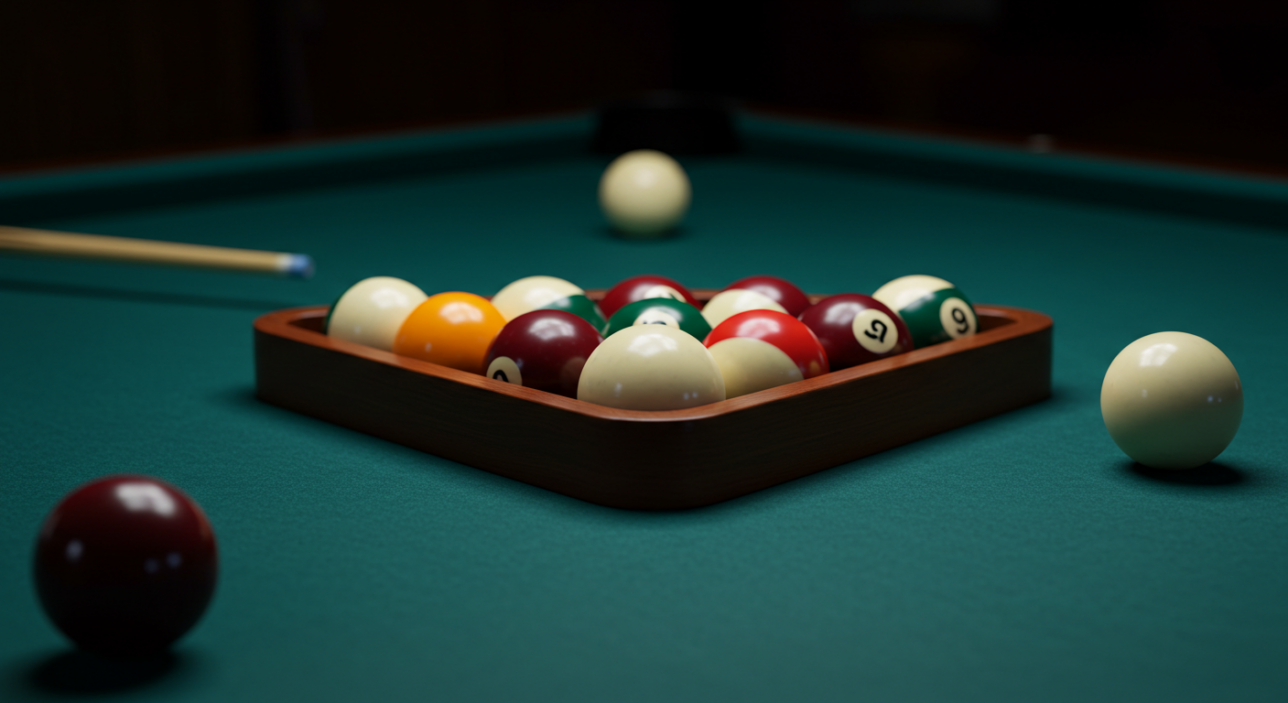
American pool uses larger balls than British pool—2¼ inches in diameter compared to 2 inches. A standard set includes 15 numbered balls (1 to 15) and a white cue ball. The 1 to 7 balls are solid colours, 9 to 15 are stripes, and the 8-ball is black.
When buying a set, quality matters. Cheap balls tend to wear quickly and can chip, leading to inconsistent rolls and damage to the table cloth. Phenolic resin balls, such as Aramith, are more expensive but offer much greater durability and consistency.
You’ll also need a triangle rack or diamond rack depending on whether you’re playing 8-ball or 9-ball. Plastic racks are fine for casual use, but wooden or heavy-duty composite racks provide better results and a cleaner break.
For added flair, some players invest in a ball tray or a stylish ball holder, but it’s optional.
Remember: mismatched sizes or low-quality balls can make your table feel sluggish or uneven. Stick with a reputable brand, and your games will feel smoother and more professional from the very first break.
4. Cloth, Brush Sets, and Table Maintenance
The cloth covering your table—also called the baize—affects everything from ball speed to spin. American pool tables typically use a worsted wool cloth, which is smoother and faster than the napped cloth used on British tables. Brands like Simonis or Championship are top choices, offering long-lasting, professional-grade surfaces.
Choose a cloth that’s designed for your specific table size. Pre-cut sets are available, making installation easier if you plan to recover the table yourself. If you’re not confident, hire a local fitter—it’s worth it for a clean, wrinkle-free finish.
To maintain your cloth, invest in a dedicated table brush with soft bristles and a cloth cleaner spray. Brush regularly in straight lines from the break end to the foot of the table to remove chalk dust and debris.
Also consider using a table cover when the table isn’t in use. This prevents dust build-up and protects the cloth from accidental spills or sunlight fading.
Regular maintenance not only keeps your table looking sharp but also ensures a consistent playing surface for years to come.
5. Lighting: See Your Shots Clearly
Good lighting isn’t just about aesthetics—it’s essential for accurate play and spot-on trick shots. Shadows and dim spots can throw off your aim and make games frustrating. The right lighting setup enhances both visibility and atmosphere.
American pool setups typically use dedicated table lighting fixtures—long bars with multiple bulbs mounted above the centre of the table. These are usually fitted around 32–36 inches above the playing surface, evenly illuminating every pocket and cushion.
If you prefer a simpler solution, track lighting or adjustable ceiling lamps can also work, as long as they minimise glare and shadows.
Opt for LED bulbs where possible—they last longer, use less energy, and provide a crisp white light that mimics daylight. Warm, yellowish bulbs might look nice but can change your depth perception.
A dim room with a bright, focused pool light creates that classic billiards-hall feel, perfect for entertaining and late-night matches.
Don’t forget about aesthetics—choose a lighting design that matches your room’s décor. Whether it’s rustic metal shades or a sleek modern fixture, lighting can really elevate your home pool space.
6. Chalk, Cue Accessories, and Extras
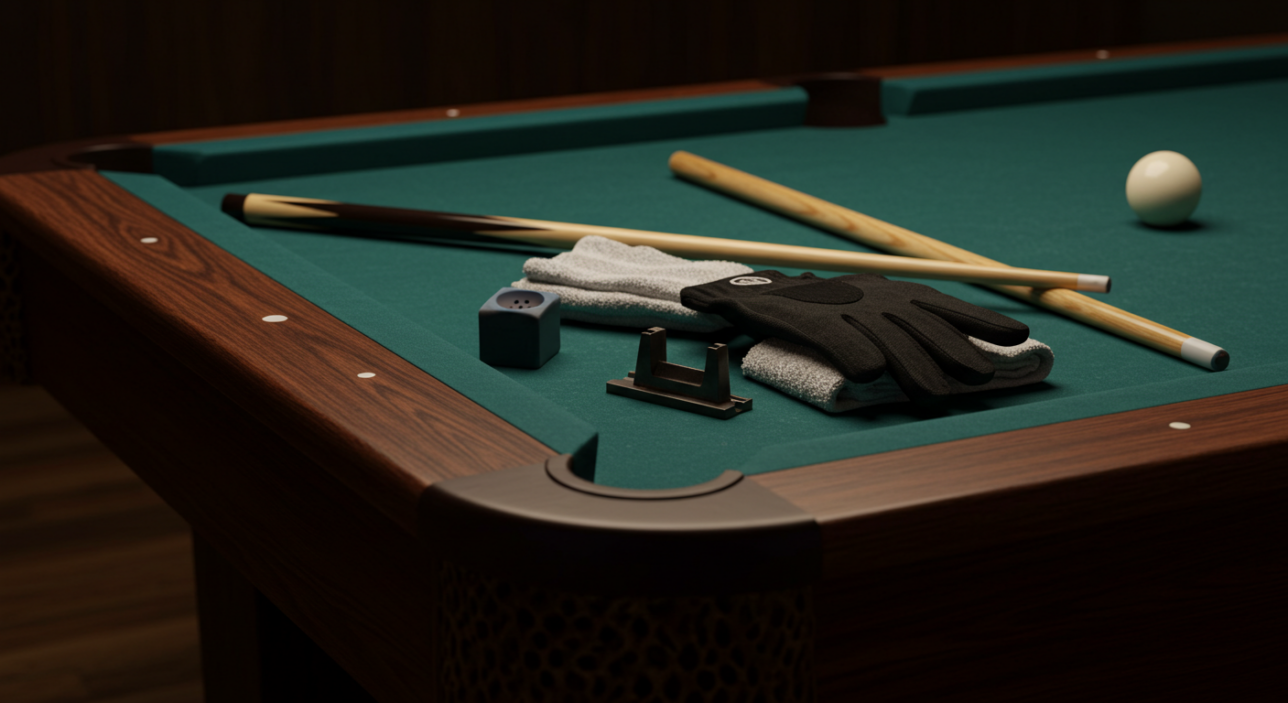
Though small, chalk plays a big role in cue ball control. It adds friction between the cue tip and ball, helping you apply spin and avoid miscues. Always use high-quality chalk like Master, Kamui, or Taom for the best grip.
Keep a few blocks on hand and encourage everyone to chalk before every shot. You’ll also want to invest in a tip shaper or cue tip pick to keep your cue in perfect playing condition.
Other helpful cue accessories include:
-
Gloves – useful for players who want smoother strokes or play in humid rooms.
-
Cue cases – ideal for storing and protecting cues, especially two-piece ones.
-
Joint protectors – preserve the threaded ends of break-down cues.
Also consider adding a cue ball cleaner and microfibre cloths to keep your balls and table components in great shape. Over time, dust and chalk build-up can affect performance, so regular upkeep matters.
Finally, you might want to include fun extras like scoreboards, drink holders, or even a wall-mounted rules plaque—these details make your home setup feel more like a true games room.
Equipment Maintenance Tips: Keep Your Pool Gear in Top Shape
Once you’ve invested in a quality American pool setup at home, it’s crucial to maintain it. Regular upkeep not only keeps your equipment looking great but also ensures consistent, professional-level play for years to come.
1. Pool Table Care
-
Cloth: Brush the cloth after every session using a soft-bristled pool table brush. Always brush in one direction to maintain the nap.
-
Vacuuming: Use a handheld vacuum (on low suction) weekly to remove dust and chalk residue, especially around pockets.
-
Levelling: Check your table’s level every few months. Uneven floors can cause balls to roll off line.
-
Covers: Invest in a heavy-duty table cover to protect from dust, sunlight, and spills.
2. Cue Maintenance
-
Chalk regularly to protect the tip and avoid miscues.
-
Use a cue tip shaper every few weeks to maintain the dome shape.
-
Store in a cue rack—never leave cues leaning against walls, as it can warp them.
3. Balls & Accessories
-
Clean cue balls and object balls monthly using a dedicated pool ball cleaner or warm, soapy water.
-
Polish wooden racks and dust chalk holders, triangle racks, and other accessories to keep them looking new.
Good habits go a long way—clean gear enhances your experience and extends the life of your equipment.
Setup Tips and Final Thoughts
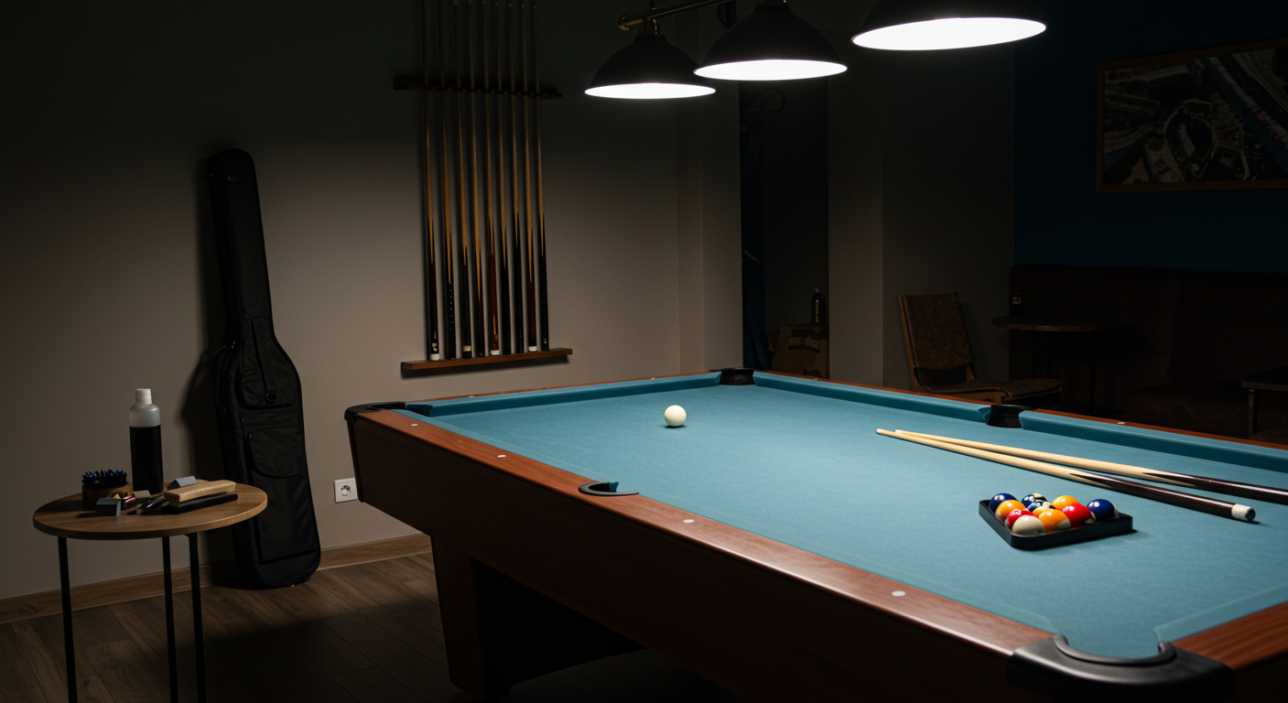
Creating a home American pool space doesn’t mean you need a massive room or unlimited budget—just smart planning and a focus on quality gear.
Start by measuring your space accurately. Not just the table’s footprint, but the full play area including cue clearance. Then, prioritise quality in key items: the table, cues, balls, and lighting. These are your core components and will influence the playing experience more than anything else.
Don’t forget to future-proof your setup. Modular furniture, foldable accessories, and portable cues give you flexibility, especially if you plan to move house or reconfigure your space.
If your goal is social, create a welcoming vibe with good lighting, music, and comfy seating. If your focus is practice, ensure the room is distraction-free and that all gear is easy to access and maintain.
Ultimately, your American pool setup should reflect your personality and playing style. Whether it’s a stylish games lounge or a functional training zone, the right equipment makes it a space you’ll want to use again and again.
FAQs: American Pool Table Equipment Questions Answered
What size pool table should I get for home use?
If space permits, an 8-foot table is ideal as it closely resembles professional standards while fitting comfortably in most home games rooms. A 7-foot table is a great alternative for tighter spaces and still offers a satisfying playing experience.
Can I use snooker or British pool cues on an American pool table?
You can, but it’s not recommended. American pool cues are built for larger balls and bigger pockets—they’re typically heavier and have wider tips, which gives better control and power for this style of play.
What’s the best cloth for American pool tables?
Worsted wool cloth, such as Simonis 860 or Championship Tour Edition, is ideal. It’s smooth, fast, and durable, providing excellent cue ball response and a professional feel.
How much space do I need around the table?
Aim for at least 1.5 metres (5 feet) of space on all sides. This allows for full cue strokes and a more enjoyable playing environment.
Do I need professional installation?
For slate-bed tables, yes—professional installation ensures the slate is level and the frame is properly assembled. Cheaper MDF tables can often be self-installed with basic tools.
How often should I change the cue tip?
For frequent players, inspect your tip every couple of months. If it’s flattened, hardened, or loses shape, it should be reshaped or replaced to maintain performance.
Is it worth buying second-hand equipment?
Absolutely—if you check it thoroughly. Look for level slates, undamaged cloth, and straight cues. Be cautious of warps, tears, or low-quality accessories that might affect your game.
